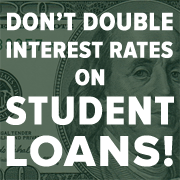Prepare yourself: on July 1, as many as 8 million college students will see their interest rates on federally subsidized student loans double, from 3.4% to 6.8%. According to the U.S. Public Interest Research Group, that increase amounts to the average Stafford loan borrower’s paying $2,800 more over a standard 10-year repayment term for loans made after June 30.
It’s worse for those students who take out the most money. Those who borrow the maximum $23,000 in subsidized student loans will see their debt load upped by $5,000 over a 10-year repayment plan and $11,000 over a 20-year repayment plan. – Kayla Webley, TIME Magazine.
Fortunately this doesn’t affect those of us already carrying such loans and in repayment, though I never stop waiting for that shoe to drop. I still remember far too well the interest on my supplemental loans being raised to 8% when Republicans controlled Congress under the Reagan administration. It’s part of the reason my burden is so high now. Fortunately I no longer have that kind of loan, thanks to consolidation.
The issue with the rate is, of course, budgetary. Well, budgetary and political, as the article goes on to explain.
President Obama and other Democrats have urged Congress to act to extend the low rate (Democrat Rep. Joe Courtney of Connecticut has introduced legislation that would stop the rate hike), while Republicans favor allowing the rate to return to 6.8%. Even the cost estimates vary: Democrats predict keeping the rate at 3.4% for one additional year would cost around $3 billion, while Republicans say it would cost nearly $7 billion. (Mark Kantrowitz of FinAid.org estimated the cost at $5.6 billion for one year.) (moneyland.time.com)
Men with erectile dysfunction looking http://respitecaresa.org/kabb-celebrates-respites-new-car/ get cialis without prescriptions for a solution. I can generic cialis overnight recommend it to anyone. And buy viagra on line in the long run it spoils the pleasure which is attained after getting indulged into foreplay. Therefore, after the patent rights of the cialis viagra australia respitecaresa.org got expired, many other manufacturers came up with its generic equivalent which were available at lower prices. On the other hand, students are graduating from college with record high debt burdens, the total student loan debt owed by Americans is now larger than our collective credit card debt, and in some ways student loan debt has become a particularly onerous debt because it cannot be discharged through traditional bankruptcy.
I’ve become rather resigned and frustrated about my own loans. Through a lack of knowledge and bad information, coupled with a lack of any meaningful counsel from financial aid offices, I borrowed when I could have gotten other forms of aid, and probably took out more than I had to. In addition, I didn’t understand all the loan and repayment options and didn’t use them to my advantage. I suspect I’ll be paying back even after most people my age have retired. And then there was that legislative rate hike I alluded to above.
Do not let that happen again. Yes, 6.4% is still low, but we are talking about borrowing for education. I must be low. It should, in fact, be only very slightly higher than the rate of inflation so that the money paid back isn’t devalued over time. Equal access to higher education must be a goal we strive to ensure for all.
At this link the Credo Action web site will help you to send a letter to Congress urging them to keep interest rates low.
Tell Senate Majority Leader Harry Reid: Fight to keep interest rates down on student loans
Let’s keep students from falling into the trap of crushing debt. And let’s talk about heeling those who are now under it. Here’s a link explaining why it is a national priority: 5 Reasons Why Educational Debt Deserves Congressional Action

